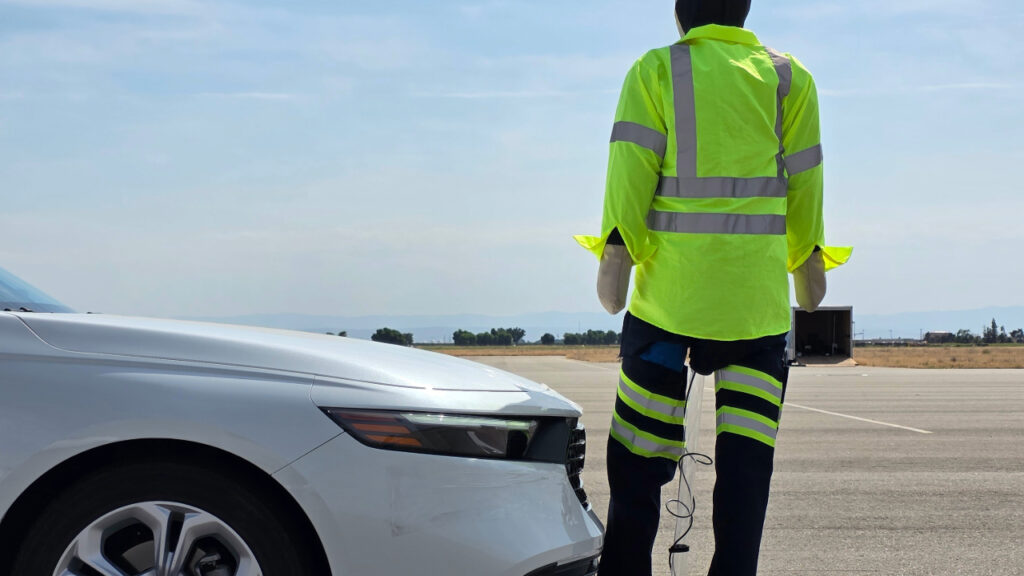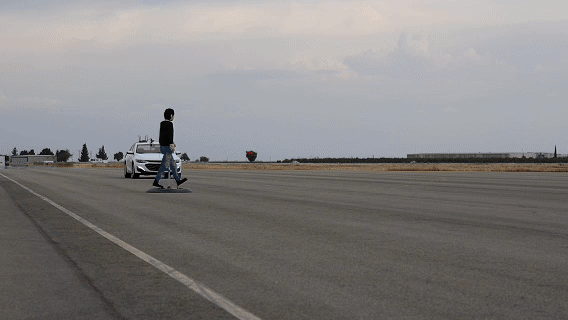AAA: Nighttime Safety Improved with Pedestrian Detection Effective Rates Rising from 0% to 60%
Orlando, Fla.—AAA evaluated vehicles equipped with pedestrian automatic emergency braking (PAEB) systems, building on findings from a study conducted in 2019. The findings reveal that nighttime PAEB impact avoidance improved from 0% in 2019 to 60% in 2025. The team also investigated whether outfitting the pedestrian target with an ANSI Class 3 ensemble, the type of high-visibility clothing used by roadside assistance providers, affects the performance of the evaluated PAEB systems. The impact of high-visibility clothing on PAEB systems varied under nighttime conditions, ranging from improved avoidance to a complete loss of detection.
In partnership with the Automobile Club of Southern California’s Automotive Research Center, AAA evaluated four vehicles with PAEB. Testing was conducted on a closed course using a robotic pedestrian adult crossing in front of the test vehicles traveling at 25 mph. Tests were conducted during the day and night with the adult pedestrian dressed in both standard, non-reflective clothing and ANSI Class 3 high-visibility apparel.
Key Findings
- Overall, nighttime PAEB impact avoidance improved from 0% in 2019 to 60% in 2025.
- ANSI Class 3 high-visibility clothing had:
- no negative effect on PAEB performance during the daytime, avoiding a collision 95% of the time.
- varied PAEB responses at nighttime, ranging from improved avoidance to complete loss of detection.
Detection and response inconsistency poses ongoing risks to pedestrian safety, given that over 75 percent of pedestrian fatalities occur after dark. Recent findings from the AAA Foundation for Traffic Safety (FTS) revealed pedestrian fatalities in the U.S. rose by over 80% in the past 15 years, with this increase occurring on urban arterial roads and after dark.
Automotive
AAA: Nighttime Safety Improved with Pedestrian Detection Effective Rates Rising from 0% to 60%
Despite advancements, high-visibility clothing can cause challenges, putting roadside assistance providers at risk.
 Brittany MoyePublic Relations & Content Manager[email protected]
Brittany MoyePublic Relations & Content Manager[email protected]
10/15/2025

ORLANDO, Fla. (Oct. 15, 2025) – AAA evaluated vehicles equipped with pedestrian automatic emergency braking (PAEB) systems, building on findings from a study conducted in 2019. The findings reveal that nighttime PAEB impact avoidance improved from 0% in 2019 to 60% in 2025. The team also investigated whether outfitting the pedestrian target with an ANSI Class 3 ensemble, the type of high-visibility clothing used by roadside assistance providers, affects the performance of the evaluated PAEB systems. The impact of high-visibility clothing on PAEB systems varied under nighttime conditions, ranging from improved avoidance to a complete loss of detection.
“Recent improvements in pedestrian automatic emergency braking systems are promising; however, there is still more work to be done,” said Greg Brannon, AAA’s Director of Automotive Engineering Research. “Most pedestrian fatalities occur at night, and these systems can make a significant difference during those hours. However, mixed performances with high-visibility clothing indicate that further refinement and testing are necessary to save more lives, including those of our roadside assistance providers.”
In partnership with the Automobile Club of Southern California’s Automotive Research Center, AAA evaluated four vehicles with PAEB. Testing was conducted on a closed course using a robotic pedestrian adult crossing in front of the test vehicles traveling at 25 mph. Tests were conducted during the day and night with the adult pedestrian dressed in both standard, non-reflective clothing and ANSI Class 3 high-visibility apparel.
Key Findings:
- Overall, nighttime PAEB impact avoidance improved from 0% in 2019 to 60% in 2025.
- ANSI Class 3 high-visibility clothing had:
- no negative effect on PAEB performance during the daytime, avoiding a collision 95% of the time.
- varied PAEB responses at nighttime, ranging from improved avoidance to complete loss of detection.
Detection and response inconsistency poses ongoing risks to pedestrian safety, given that over 75 percent of pedestrian fatalities occur after dark. Recent findings from the AAA Foundation for Traffic Safety (FTS) revealed pedestrian fatalities in the U.S. rose by over 80% in the past 15 years, with this increase occurring on urban arterial roads and after dark.

According to the National Highway Traffic Safety Administration (NHTSA), in 2023, an estimated 7,314 pedestrians were killed, and more than 68,000 pedestrians were injured nationwide. Additional concerns are raised when considering AAA’s roadside assistance providers wear high-visibility gear while working in high-speed traffic or hazardous environments. The AAA Foundation for Traffic Safety analysis of data from the Emergency Responder Safety Institute found an average of 23 roadside assistance providers a year, including tow providers, were struck and killed by vehicles while working at the roadside in the years 2020-2024.
AAA recommends drivers always remember
- Pedestrian Automatic Emergency Braking (PAEB) systems are never a substitute for an engaged driver – do not rely on pedestrian detection systems to prevent a crash.
- Drive with extra caution at night, as this is the riskiest time for pedestrians.
- Remember to stay alert! Engaging in risky driving behaviors such as speeding, texting, driving while drowsy or distracted, or driving under the influence of cannabis or alcohol significantly increases the risk of a collision. Follow speed limits, keep your smartphone out of reach, and only drive when sober.
- Read the owner’s manual to understand what safety systems the vehicle is equipped with and how they operate.
Drivers are responsible for yielding to pedestrians, but those traveling on foot should also be vigilant. Pedestrians should stay cautious by staying on sidewalks and using crosswalks whenever possible. Always obey traffic signals, look both ways before crossing the street, and refrain from walking and texting or engaging with your phone. Be extra careful at nighttime, even while wearing high-visibility clothing.
Manufacturers should enhance the reliability of PAEB systems during nighttime conditions. Evaluations should also consider the system’s effectiveness when pedestrians wear different types of apparel, particularly high-visibility clothing.
Regulators and standards organizations are encouraged to improve pedestrian safety protocols by including more nighttime scenarios involving high-visibility apparel. Expanding evaluation practices will provide a better assessment of PAEB performance and help reduce pedestrian injuries and fatalities.
To protect roadside assistance providers, drivers with disabled vehicles, and others, and to improve highway safety, AAA offers these precautionary tips:
- Remain alert, avoid distractions and focus on the task of driving.
- Keep an eye out for situations where emergency vehicles, tow trucks, utility service vehicles or disabled vehicles are stopped on the side of the road.
- When you see these situations, slow down and, if possible, move one lane over and away from the people and vehicles stopped at the side of the road.
Methodology
In partnership with the Automobile Club of Southern California’s Automotive Research Center, closed-course testing was conducted on roadways specifically designed for standardized ADAS testing on the grounds of Minter Field Airport in Shafter, California. All test scenarios were conducted on a vehicle dynamics pad comprised of straight, flat, dry asphalt free of visible moisture, potholes, or irregularities that could affect the trajectory of the test vehicles or target.
Four test vehicles were selected: the 2024 Honda Accord, the 2025 Toyota Camry, the 2025 Chevrolet Malibu, and the 2025 Tesla Model 3. Each vehicle was evaluated under controlled day and night conditions, traveling at a constant speed of 40 km/h (25 mph) toward a perpendicular crossing pedestrian. Tests compared results from 2019 with standard and ANSI Class 3 high-visibility clothing, recording system warnings, braking responses, and outcomes. Complete methodology can be found in the full research report here.
